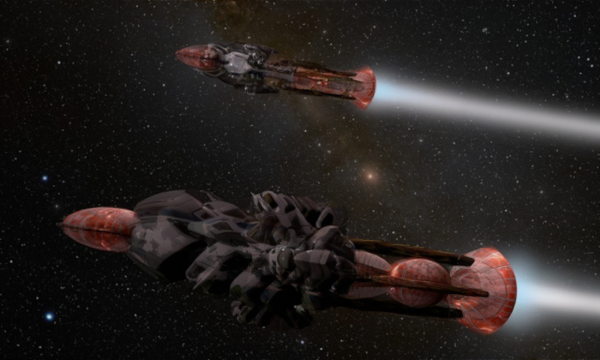BY LETTER
Ghosts of the Cambrian
Galactography > Other Major Polities, Empires, and Meta-Empires > Hiders
Sophonts > Modosophonts > Sophont Ships
Sophonts > Modosophonts > Sophont Ships
 Image from Steve Bowers and Artbreeder AI |
From the earliest days of lazurogenics during the late Information Age, there has been considerable fascination among amateur gengineers with recreating the fauna of Earth's Cambrian Era (538.8-485.4 million years BT). The fossil record from this era featured an incredible diversity of bizarre and outlandish organisms, many of which seemed as alien to modern life on Earth as the actual aliens that would later be encountered by Terragen civilization.
Faithfully recreating these species posed a particular challenge for lazurogenicists, as not only was there no original genetic material to work with, but there were virtually no living organisms that even remotely resembled Cambrian species, much less any that were close relatives. Even the fossils of Cambrian taxa were often so strange and ambiguous as to defy easy reconstruction. Nevertheless, between the late Information Age and early Federation Age there were countless attempts to replicate Cambrian taxa, with widely varied results. Most well-known among these are the Anomalocaroids, a loose family of neogens and splices modeled on the predatory species Anomalocaris, one of the most famous Cambrian creatures.
Over the following millennia, hundreds of clades of Cambrian lazurogens (collectively referred to as neo-Cambrians) were spread across the Terragen Sphere, typically as pets or exhibits in zoological gardens and zooeums. Many became subject to further gengineering, cyborgization and/or provolution by hobbyists; among these were a host of microgravity- and vacuum-adapted forms designed to survive in open space, some of which could grow to massive sizes and effectively become bioships. Many an orbital spaceport throughout the Terragen Sphere has been graced by the otherworldly sight of schools of huge spaceborne trilobites, ammonites, orthocones, anomalocaridids, Hallucigenias, Wiwaxias, and myriad other Cambrian taxa floating serenely past viewports and flocking to welcome incoming vessels with elaborate swirling dances.
Over time, many of these spacegoing neo-Cambrian lineages further diverged and evolved through either natural or artificial means, with many adopting even stranger forms and becoming virtually unrecognizable as Terragen-derived beings. Several sophont clades established their own cultures, living on the periphery of inhabited space and interfacing to a greater or lesser degree with the rest of Terragen civilization. Of these, one group in particular has become especially well-known, while at the same time being exceptionally reclusive. Their name for themselves is unknown, but observers have given them the moniker "Ghosts of the Cambrian."
The Ghosts appear to be a diverse collection of deep-space-living neo-Cambrians, with members derived from almost every known Cambrian taxa having been sighted at one point or another. Most individuals tend to be quite large, though not exceptionally so, ranging in size from fifty to two hundred meters in length. Interestingly, in contrast to many spaceborne neo-Cambrian clades, all individuals thus far encountered seem to exhibit forms closely resembling the "ancestral" species on which they were initially modeled, insofar as this can be determined from the fossil record. While they must necessarily be heavily modified and likely cyborgized/bioborgized in order to survive in deep space, no outward signs of these modifications can be seen. No visible mode of propulsion has likewise been identified, leading many to speculate that they utilize some form of reactionless drive. If so, this would suggest that they collectively must be unusually advanced, as no other neo-Cambrian clade is known to use S4-derived technologies.
Almost nothing else is known about these secretive beings. They have been sighted in inhabited systems throughout the Sephirotics and beyond, but no one knows where they originated, whether they are an organized society or a loosely-affiliated group of loners, or what their culture is like, if they even have one. In nearly every encounter, they have been spotted at great distance, seemingly observing the local goings-on, before suddenly disappearing without so much as acknowledging a radio or tightbeam hail.
On a few rare occasions, high-level transapients have reported that they have made contact with members of the Ghosts. In all of these described encounters, there is never any exchange of information, with the Ghosts declining to answer queries or make any of their own. Instead, all that is conveyed is an emotional impression of deep melancholy, sometimes tinged with feelings of envy and resentment.
This, combined with their evident shyness and adherence to conservative bodyplans, has led some to speculate that the Ghosts as a whole are subject to particularly acute lazurogen angst, perhaps to a greater degree than any other sophonts derived from reconstructions of extinct species. According to this hypothesis, the Ghosts regard themselves as the frivolous products of amateur gengineers, with their ancestors having been flawed copies of their ancient counterparts, "resurrected" for the entertainment of strange and capricious beings and thrown into a universe vastly different from that of their original templates. It would seem that even with their augmented intelligence and the stars now at their metaphorical fingertips, they still feel themselves to be out of place and time.
Related Articles
- Anomalocaris
- Anomalocaroids
- Bioship
- Lazurogen Angst
- Lazurogenics
- Neo-Cambrians - Text by Andrew P
Any of various clades derived from neogenic or spliced "lazurogens" of extinct taxa from Earth's Cambrian Era; the paraphyletic superclade known as anomalocaroids (modeled on the predatory genus Anomalocaris) are among the oldest and most widely-known Neo-Cambrians. - Vacuum Flora and Gardens
Appears in Topics
Development Notes
Text by Andrew P
Initially published on 27 September 2024.
Initially published on 27 September 2024.






